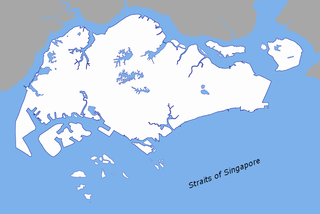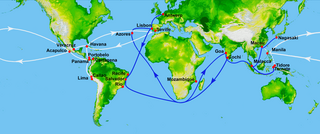 W
WThe Arctic Bridge or Arctic Sea Bridge is a seasonal sea route approximately 6,700 kilometres long linking Russia to Canada, specifically the Russian port of Murmansk to the Hudson Bay port of Churchill, Manitoba.
 W
WClimate change in the Arctic is causing major environmental issues. These range from the well known, such as the loss of sea ice or melting of the Greenland ice sheet, to more obscure, but deeply significant issues, such as permafrost thaw, social consequences for locals and the geopolitical ramifications of these changes.
 W
WArctic shipping routes are the maritime paths used by vessels to navigate through parts or the entirety of the Arctic. There are three main routes that connect the Atlantic and the Pacific oceans: the Northeast Passage, the Northwest Passage, and the mostly unused Transpolar Sea Route. In addition, two other significant routes exist: the Northern Sea Route, and the Arctic Bridge.
 W
WThe European-Asian sea route, commonly known as the sea route to India or the Cape Route, is a shipping route from the European coast of the Atlantic Ocean to Asia's coast of the Indian Ocean passing by the Cape of Good Hope and Cape Agulhas at the southern edge of Africa. The first recorded completion of the route was made in 1498 by Portuguese explorer Vasco da Gama. The route was important during the Age of Sail, but became partly obsolete as the Suez Canal opened in 1869.
 W
WThe Chief Directorate of the Northern Sea Route, also known as Glavsevmorput or GUSMP, was a Soviet government organization in charge of the maritime Northern Sea Route, established in January 1932 and dissolved in 1964.
 W
WFuelling stations, also known as coaling stations, are repositories of fuel that have been located to service commercial and naval vessels. Today, the term "coaling station" can also refer to coal storage and feeding units in fossil-fuel power stations.
 W
WThe International North–South Transport Corridor (INSTC) is a 7,200-km-long multi-mode network of ship, rail, and road route for moving freight between India, Iran, Afghanistan, Azerbaijan, Russia, Central Asia and Europe. The route primarily involves moving freight from India, Iran, Azerbaijan and Russia via ship, rail and road. The objective of the corridor is to increase trade connectivity between major cities such as Mumbai, Moscow, Tehran, Baku, Bandar Abbas, Astrakhan, Bandar Anzali, etc. Dry runs of two routes were conducted in 2014, the first was Mumbai to Baku via Bandar Abbas and the second was Mumbai to Astrakhan via Bandar Abbas, Tehran and Bandar Anzali. The objective of the study was to identify and address key bottlenecks. The results showed transport costs were reduced by "$2,500 per 15 tons of cargo". Other routes under consideration include via Kazakhstan and Turkmenistan.
 W
WThe Intracoastal Waterway (ICW) is a 3,000-mile (4,800 km) inland waterway along the Atlantic and Gulf of Mexico coasts of the United States, running from Boston, Massachusetts, southward along the Atlantic Seaboard and around the southern tip of Florida, then following the Gulf Coast to Brownsville, Texas. Some sections of the waterway consist of natural inlets, saltwater rivers, bays, and sounds, while others are artificial canals. It provides a navigable route along its length without many of the hazards of travel on the open sea.
 W
WThe Japan voyage was a trade route established by the Portuguese from 1550 to 1639 linking Goa, then capital of the Portuguese India, to Japan. This lucrative annual trip was carried out under monopoly of the Portuguese crown, and was in charge of a Captain general. The charge of Captain general of the Japan's trip was officially attributed by the governor of Portuguese India as a reward for services rendered. The large ships involved in this trade were referred to as the nau do trato, the silver ships, China's ships, and became known among the Japanese as Kurofune, a term that came to be used to name all Western ships that supplied in Japan during the Edo period.
 W
WThe kitamaebune was a shipping route in Japan from the Edo period to the Meiji era. The route went from Osaka through the Seto Inland Sea and the Kanmon Straits to ports in Hokuriku on the Sea of Japan and later to Hokkaidō.
 W
WThe Manila Galleons were Spanish trading ships which for two-and-a-half centuries linked the Spanish Captaincy General of the Philippines with Mexico across the Pacific Ocean, making one or two round-trip voyages per year between the ports of Acapulco and Manila, which were both part of New Spain. The name of the galleon changed to reflect the city that the ship sailed from. The term Manila galleon can also refer to the trade route itself between Acapulco and Manila, which lasted from 1565 to 1815.
 W
WThe Northeast Passage is, from the European and northern Atlantic point of view, the shipping route to the Pacific Ocean, along the Arctic coasts of Norway and Russia. The western route through the islands of Canada is accordingly called the Northwest Passage (NWP).
 W
WThe Northern Sea Route is a shipping route officially defined by Russian legislation as lying east of Novaya Zemlya and specifically running along the Russian Arctic coast from the Kara Sea, along Siberia, to the Bering Strait. The entire route lies in Arctic waters and within Russia's exclusive economic zone (EEZ). Parts are free of ice for only two months per year. The overall route on Russia's side of the Arctic between North Cape and the Bering Strait has been called the Northeast Passage, analogous to the Northwest Passage on the Canada side.
 W
WThe Northwest Passage (NWP) is the sea route between the Atlantic and Pacific oceans through the Arctic Ocean, along the northern coast of North America via waterways through the Canadian Arctic Archipelago. The eastern route along the Arctic coasts of Norway and Siberia is accordingly called the Northeast Passage (NEP). The various islands of the archipelago are separated from one another and from Mainland Canada by a series of Arctic waterways collectively known as the Northwest Passages or Northwestern Passages.
 W
WThe Penang Strait is an 11 kilometre-wide strait that separates Penang Island from mainland Malay Peninsula. Penang Island is to the west of the channel, while Seberang Perai, the mainland half of the State of Penang, is to the east. The northern and southern ends of the channel join the Strait of Malacca, one of the world's busiest maritime routes.
 W
WThe Singapore Strait is a 114-kilometer-long (71 mi), 16-kilometer-wide (9.9 mi) strait between the Strait of Malacca in the west and the South China Sea in the east. Singapore is on the north of the channel, and the Riau Islands are on the south. The Indonesia-Singapore border lies along the length of the strait.
 W
WDuring the Spanish colonization of the Americas, the Spanish Main was the collective term for the parts of the Spanish Empire that were on the mainland of the Americas and had coastlines on the Caribbean Sea or Gulf of Mexico. The term was used to distinguish those regions from the numerous islands Spain controlled in the Caribbean, which were known as the Spanish West Indies.
 W
WThe Spanish treasure fleet, or West Indies Fleet Spanish: Flota de Indias, was a convoy system of sea routes organized by the Spanish Empire from 1566 to 1790, which linked Spain with its territories in the Americas across the Atlantic. The convoys were general purpose cargo fleets used for transporting a wide variety of items, including agricultural goods, lumber, various metal resources such as silver and gold, gems, pearls, spices, sugar, tobacco, silk, and other exotic goods from the overseas territories of the Spanish Empire to the Spanish mainland. Spanish goods such as oil, wine, textiles, books and tools were transported in the opposite direction.
 W
WThe St. Lawrence Seaway is a system of locks, canals, and channels in Canada and the United States that permits oceangoing vessels to travel from the Atlantic Ocean to the Great Lakes of North America, as far inland as Duluth, Minnesota, at the western end of Lake Superior. The seaway is named for the St. Lawrence River, which flows from Lake Ontario to the Atlantic Ocean. Legally, the seaway extends from Montreal, Quebec, to Lake Erie, and includes the Welland Canal.
 W
WThe Strait of Malacca or Straits of Malacca is a narrow stretch of water, 580 mi (930 km) in length, between the Malay Peninsula and the Indonesian island of Sumatra. As the main shipping channel between the Indian Ocean and the Pacific Ocean, it is one of the most important shipping lanes in the world. It is named after the Malacca Sultanate that ruled over the archipelago between 1400 and 1511, the center of administration of which was located in the modern-day state of Malacca, Malaysia.
 W
WThe Transpacific Stabilization Agreement (TSA) is a research and discussion forum used by 15 of the main container shipping lines which carry cargo between Asia and the United States. The agreement operates differently and has different membership for eastbound and westbound carriage. U.S. authorization falls under the oversight of the Federal Maritime Commission.
 W
WThe Transpolar Sea Route (TSR) is a future Arctic shipping route running from the Atlantic Ocean to the Pacific Ocean across the center of the Arctic Ocean.
 W
WTriangular trade or triangle trade is a historical term indicating trade among three ports or regions. Triangular trade usually evolves when a region has export commodities that are not required in the region from which its major imports come. Triangular trade thus provides a method for rectifying trade imbalances between the above regions.
 W
WIn the Middle Ages, the Volga trade route connected Northern Europe and Northwestern Russia with the Caspian Sea and the Sasanian Empire, via the Volga River. The Rus used this route to trade with Muslim countries on the southern shores of the Caspian Sea, sometimes penetrating as far as Baghdad. The powerful Volga Bulgars formed a seminomadic confederation and traded through the Volga river with Viking people of Rus' and Scandinavia and with the southern Byzantine Empire Furthermore, Volga Bulgaria, with its two cities Bulgar and Suvar east of what is today Moscow, traded with Russians and the fur-selling Ugrians. Chess was introduced to Old Russia via the Caspian-Volga trade routes from Persia and Arabic lands.
 W
WThe York Factory Express, usually called "the Express" and also the Columbia Express and the Communication, was a 19th-century fur brigade operated by the Hudson's Bay Company (HBC). Roughly 4,200 kilometres (2,600 mi) in length, it was the main overland connection between HBC headquarters at York Factory and the principal depot of the Columbia Department, Fort Vancouver.